Menus
Super underbone
Single cylinder rotary valve 115 cm3 and 20 hp for 67 kg
Imagine yourself on a racetrack 45 years ago, driving a Yamaha TA125, the manufacturer’s very first twin-cylinder competitor. You will be racing in the front row of the 125cc class, but suddenly and without warning you are passed under braking on a twisty section by someone sitting in a very upright posture on a bright red motorcycle and whose only sight is a double surprise. Why ? Because he drives a Suzuki Stepthru, that’s why, a machine that would normally have no right to be on the track next to you, nor to ride so hard and worse, to beat you in turns! Better get used to it mate, because back then a lot of riders on their racing bikes had to put up with being beaten by Graeme Laing on his prepped Suzuki Super-Stepthru 115 !
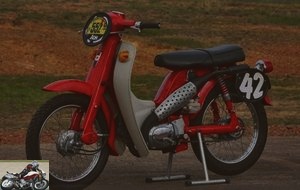 Suzuki F50 Super Stepthru review
Suzuki F50 Super Stepthru review
Discovery
Dare to be different in the race and you will be noticed. But if you can race with something different that is also effective, it’s a double challenge that can pay off well, promotional speaking. This is the reasoning which in 1970 led the Australian Graeme Laing, founder and CEO of the Melbourne Motorcycle Company (MMC), then a distributor of Suzuki motorcycles in the state of Victoria, to cover both sides of the equation by entering the race to show the potential of the Japanese brand. At the time Suzuki was indeed the poor relation of the Japanese manufacturers vis-a-vis Honda and Yamaha on the world markets. Indeed, until the beginning of the T500 with parallel twin in 1968, Suzuki had not made a competitor bigger than its T20 of 250 cm3. The brand also had no sporting reference in Australia. But Laing was determined to get some.
In 1969, Graeme hired Peter Jones, his mechanic and later service manager, in the Australian TT at Surfers Paradise which was rewarded with an incredible triple victory at the country’s most important race meeting during this pre-Australian GP era. Jones won the 250, 350 and 500 races on the MMC quarter-liter twin and finished third in the Unlimited race against twice the displacement motorcycles. By showing his customers that Suzuki produced high-performance motorcycles, Laing then decided to compete in the 125 class himself on an F50 Stepthru with an underbone frame prepared with a factory racing engine..
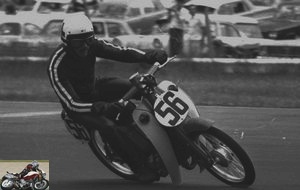 Graham Laing on the Suzuki Super Stepthru а Calder in November 1970
Graham Laing on the Suzuki Super Stepthru а Calder in November 1970
Peter Jones :
I met Graeme for the time in the early 1960s and we became friends. In 1965 he started Melbourne Motorcycles and in 1965-66 he paid me to assemble the first Suzuki cargo ever to arrive in Victoria. I managed to do it without too many hiccups so he offered me a full time job and I became the second employee of the company. This was the start of an association that lasted until 1982 when Suzuki Australia took over MMC Along with other staff members I was fortunate enough to work in a place where racing motorcycles were truly appreciated and not only tolerated, thanks to Graeme who took part in the races himself. I had a lot of success with the TR 250/500 and later with the RG 500. To say that I was lucky would be an understatement, but it’s all thanks to the boss. !
Tall and slim, but also light, Graeme Laing was already an efficient rider when he started racing in 1958 on a modified BSA Bantam. After starting Melbourne Motorcycles, he began to ride a 1967 A100 in his spare time when he was not trying to impose Suzuki on the Australian market. This was fitted with a factory racing kit originally developed for motocross, as it is unlikely that the Suzuki factory could have expected anyone to seriously drive an A100 in road races. It was an affordable rotary valve model that sold in large numbers from 1966 to 1976. The factory kit allowed performance to be increased by using the lessons learned from the Suzuki GP 50/125 on which the New Zealander Hugh Anderson won the world championships between 1963 and 1965. These technologies all employed rotary valves stolen from the MZ Communists after his star pilot Ernst Degner fled west and then to Japan in 1961, taking with him the technical secrets of the MZ. engineer MZ Walter Kaaden.
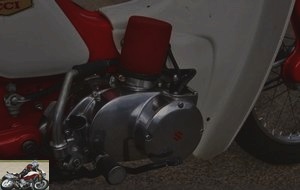 The A100 engine has been rebored to 115cc
The A100 engine has been rebored to 115cc
The A100 began its career as an air-cooled 50x50mm single-cylinder, 50x50mm single-cylinder road motorcycle, but according to Suzuki USA # 2 Technical Review dated August 1, 1969, the fitment of the racing kit resulted in an increase in power to 17 horsepower, nearly double the 9.5 hp of the standard A100. This kit included quite a few parts since it consisted of a new sportier rotary valve, an overhauled cylinder head, a larger 20mm Mikuni carburetor, an improved piston, a CDI ignition of the internal rotor, an expansion chamber exhaust, shortened ratios for the four-speed gearbox and a small oil reservoir to contain the necessary lubricant. The Posi-Force injection system directed oil to the crankshaft bearings and cylinder walls through oil lines and a gear driven pump independent of the crankshaft, rather than through a more conventional fuel-oil mixture..
Peter Jones recalls that Graeme Laing asked the Suzuki factory in 1967 if it was possible to increase the engine capacity of the A100 from 98 to 125cc, to which they replied: "It did not designed to be converted to a 125cc sports car. "
However, in early 1969 Graeme again asked Suzuki for their advice on increasing the cylinder bore of the A100 to 54mm via a T20 Wiseco piston, thus reaching 115cc in order to compensate for the 20% capacity handicap of the A100’s engine and also if they could suggest any modifications to improve handling. The answer was not long in coming:
We have already tested [the capacity increase] several times. However, decreasing the thickness of the cylinder from 4 mm to 2 mm causes thermal deformation of said cylinder, leading to serious problems of piston seizure. To overcome this problem, we made the special cylinder, the thickness of which is 3mm. We can provide you with two if you wish.
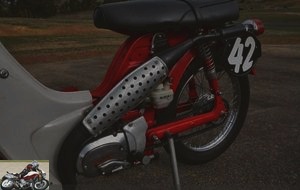 In its new configuration, the engine develops around 20 horsepower
In its new configuration, the engine develops around 20 horsepower
Suzuki also had suggestions on improving handling which involved replacing the standard swingarm rubber bushings with metal bushings and even provided part numbers for the required components. They also provided diagrams suggesting the location of gussets on the frame and swingarm to increase stiffness, adding that: “Our only distributor in Venezuela has been successful in improving handling and stability with the use of Ceriani forks and Girling shock absorbers ". Graeme Laing was therefore not the only one to race on the road with an A100. !
However, Graeme’s priority was the engine. He therefore immediately ordered the proposed cylinders and requested a few modified cylinder heads due to the increased displacement. The cylinders were supplied with an explanation of the modifications required. Graeme also modified the Wiseco piston and the 115cc A100-2 to transform the whole into a 125 class sports car. The increase in performance as well as three break-in seasons of the small two-stroke allowed Laing to win at Hume. Weir in 1970, beating Len Atlee, top Australian 125 class rider on Yamaha CSD and he finished second behind Bultaco TSS125 of future TT Classic winner Bill Horsman at Winton. He also signed other top 5 against the best 125 of the time in Australia..
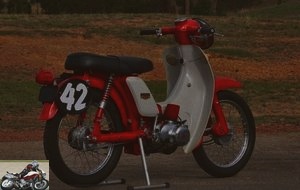 The engine preparation was then adapted to a Stepthru
The engine preparation was then adapted to a Stepthru
But although the small 115cc Suzuki A100-2 was now quite competitive, Laing had the idea of taking a Suzuki F50 Stepthru and placing it in the 125 class in 1971..
“If you can’t win, at least you can put on a show,” Graeme said at the time. But on this unlikely machine, he did both !
After performing the transplant, Laing went to the annual Phillip Island New Years reunion and, just to make sure he would stand out racing on what was already a remarkable machine, he wore a full suit (with collar and tie!) over his leathers. A choice of dress that provoked hilarity. The next SuperStepthru outing was at McNamara Park where Graeme once again found himself in his costume, ready for a business lunch. Victorian officials, however, ruled that this outfit was not in the best interest of the sport, going so far as to prohibit him from appearing in his costume. The latter had in particular received complaints from spectators concerning "the man on the scooter who drove without protective leathers".
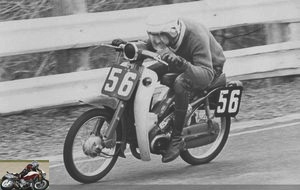 Graeme Laing а Sandown wearing, not his forbidden tuxedo, but a sweater over his leather
Graeme Laing а Sandown wearing, not his forbidden tuxedo, but a sweater over his leather
For the next two years, the SuperStepthru became the crowd icon wherever it appeared. For Graeme, the Suzuki underbone frame was fast enough to have fun. It was competitive enough to consistently place in the top five although the advent of the more powerful Yamaha AS3 twins and the later TA125 customer compe- tition marked the end of the A100’s 115cc mono. But she was super reliable, with only two retirements in the race when Graeme fell in the wet at Calder and crashed into a fallen driver right in front of him on the same circuit. A few more changes made handling even better, although with an ultra-short wheelbase of just 1,040mm, it got very lively on bumps! According to Peter Jones, Laing intended to make a longer swingarm to solve this problem, but with a business to run and many other racing motorcycles, including the new GT 750, Laing had no time to s take care of these modifications before selling this machine. The A100-powered SuperStepthru ended up in the hands of Duncan Simons who occasionally piloted it until he needed to rebuild the engine..
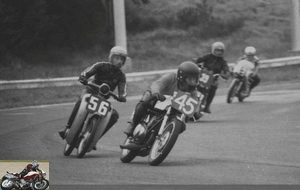 Relaxation position for Laing behind an attacking Peter Hagan on his Yamaha at Sandown Park in 1972
Relaxation position for Laing behind an attacking Peter Hagan on his Yamaha at Sandown Park in 1972
To do this, he gave the engine to Peter White, mechanic from a local motorcycle shop who now owns the model:
I have always had a soft spot for Stepthru! I first saw the Suzuki when I was 14 and fell in love with it. I’ve seen it a lot of times at Calder and really admired Graeme Laing’s skill on his handlebars. When I rebuilt Duncan’s engine, I told him if it was for sale, I wanted it. But he didn’t sell it, then he loaned it to someone to run in Broadford. The clutch was slipping and this guy was mistreating him, so when he came back about months for repairs I said to Duncan, "You don’t get it back, tell me when you know how much you want it !
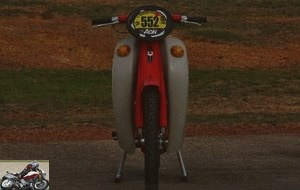 The Super Stepthru can count on a featherweight of just 67 kg
The Super Stepthru can count on a featherweight of just 67 kg
The money changed hands in 1993, but soon after Peter White’s racing career came to a standstill:
I was testing a customer’s Kawasaki ZX10 when I collided with a car that I passed over before hitting another oncoming. I broke my back and didn’t ride for 10 years.
But in 2005, with the SuperStepthru restored during his forced layoff, Peter entered the historic Australian Championship at Symmons Plain, Tasmania:
It was only the fourth time that I have driven it. I did three races at Broadford and qualified each time on pole for the 125 race. In Tasmania I qualified second and finished fourth in the race..
 Peter White and Super Stepthru resume competition in 2005 in Tasmania
Peter White and Super Stepthru resume competition in 2005 in Tasmania
According to him, the Suzuki is ultimately very close to a stock version for such a competitive and unusual machine:
It still has the original suspensions and brakes, even the front drum of the F50 is original, the speedometer still works perfectly. The body is original and I only replaced the nacelle and the rear fender. It comes with a racing cylinder aftermarket kit and a short ratio gearbox, which I still have and it’s almost as fast as a TA125. But the first gear is quite long, so you lose five seconds at the start line and then you have to try to make up for it in the corners. I weigh a little more than Graeme Laing, more than the bike itself since it is only 67 kg !
Test
She weighs less than me! A point that I learned to appreciate when Peter let me take my seat on this uber-underbone on the Broadford circuit north of Melbourne for the Bike Bonanza. I spent most of the first two laps laughing out loud in my Arai.
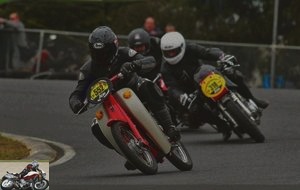 And off we go for an unlikely test at the Broadford circuit
And off we go for an unlikely test at the Broadford circuit
I’ve driven some pretty wacky sports cars, but certainly nothing as unlikely as the Suzuki Super Stepthru. It’s not so much the fact that it’s so clearly designed to race on the track, but the fact that it does it so well. The way I overtook a 350cc Norton Manx in the straight line with twice the horsepower but also twice the weight of my little two-stroke single-cylinder gave me a glimpse of the performance available. Obviously, the 17 horsepower stated on the Suzuki spec sheet was comfortably surpassed by the 98cc A100 engine thanks to the 2mm bore to reach 115cc. There’s no tachometer, but you can feel when it’s time to change gears, when power is stagnating at what I’m guessing to be 8,000 rpm, even though I kept my fingers on the gear. light clutch, just in case I got it wrong and you need to avoid overspeeding. The left-foot gear selector is well set and so easy to engage in those short gears that you only need to touch it with your toe to shift. The first gear is indeed very long, so you have to play a little with the clutch to keep the engine in its operating speed at the start and exit of a slow turn, but after that, the next three gears in the gearbox four-speed gears are evenly spaced. The instrumentation is based solely on the original speedometer which, since it only goes up to 100 km / h, sees its needle spend most of the time outside the graduation !
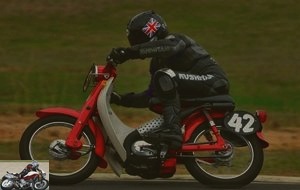 With its twenty horses, the meter graduated to 100 km / h is no longer sufficient
With its twenty horses, the meter graduated to 100 km / h is no longer sufficient
The Suzuki is indeed very short and quite thin, with the knee protectors giving a false impression of width when stationary which disappears completely as soon as you overlap the long and narrow saddle and start the engine with your foot. right. Despite the muffler installed, Graeme Laing never raced with since a muffler-less exhaust was installed. There is a powerful rumble from the exhaust which runs backwards inside the left leg. Although very compact, the riding position is very natural because you can step back on the saddle to lie behind the handlebars in a straight line, then move forward again to straighten up when approaching a bend and braking phases. . This is not the strong point of the bike as it is necessary to use the two very strong 120mm SLS drums to start slowing the machine down and they inevitably start to lose biting after three successive big brakes in each round the Broadford track, the latter recovering only in the two long straights. Here we are well within the standards of the Stepthru. You really have to anticipate your braking to stop the Super Stepthru because the brakes are not at all level given the speeds that can be reached. Gravity remains a precious help, including turn 1 uphill which is approached in second at Broadford and which invites to throw the Suzuki at the point of rope and let the braking end alone on the angle while we take advantage descent to regain power before returning to the main straight. It’s nice.
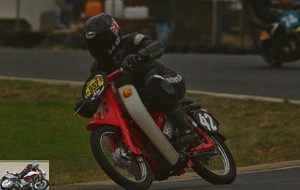 120mm drums quickly lose their effectiveness on heavy braking
120mm drums quickly lose their effectiveness on heavy braking
However, that’s not a word I would use to describe the handling of the Super Stepthru. She seems super uncertain and super nervous at all times. Stability is a very relative term here, especially when the front axle descends slightly downhill before the straight line and the bike begins to shake on either side. My first few laps were spent accepting that and learning not to oversteer on a curve because of the super light steering. I finally got used to it and that’s when I started laughing to myself again at the improbability of it all. Passing through the Esses almost in autopilot mode and then braking late, no choice, in the 180 ° of the Paddock is particularly satisfying, especially thanks to the surprisingly good grip of the Michelin M45 tires..
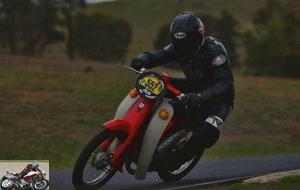 Very agile, the Suzuki asks to take the hand to avoid oversteering
Very agile, the Suzuki asks to take the hand to avoid oversteering
Conclusion
This featherweight that gives the smile must have been very fun to drive in the race and still is according to Peter White who concedes only one regret:
In 1995, I used the veto against Graeme Laing when he was riding a suit over his leathers as an inspiration to make a jumpsuit that had a tuxedo-like top with black pants underneath. It was complete with even the bow tie and handkerchief in the pocket! I actually won my first race on the Suzuki with this set and still have them. Unfortunately like so many leathers they shrink if you leave them in a room for too long which is why I can’t wear them anymore !
Ah, tempus fugit…
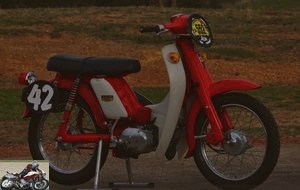 The one and only Suzuki F50 Super Stepthru
The one and only Suzuki F50 Super Stepthru
Strong points
- Fun machine
- Agility
- Lightness
Weak points
- Braking
- Stability
Suzuki F50 Super Stepthru technical sheet
Related articles
-
Test Yamaha XTZ 750 Super Tenere
Twin-cylinder in-line, 749 cm3, 70 hp, 6.8 m / kg, 195 kilos dry, from € 1,000 Produced from 1989 to 1995, this big and reliable road trail smells of…
-
197 hp at 9,500 rpm, 155 Nm at 7,200 rpm, 3 engine maps, 300 km / h, € 15,499 Cut for speed, does the myth stand up to the ravages of time? ? Thursday 11…
-
Suzuki GSX 1200 motorcycle test
The Inazuma does part of the Bandits family thanks to its engine, which is none other than the block of the 1200 Bandit. Released mid-99, this machine…
-
60,000 km in Suzuki Bandit 600S model 1999 When we speak of Suzuki Bandit, we no longer speak of a motorcycle but of a phenomenon. Because at the time of…
-
Birthday 4 cylinders in line, 1000 cm3, 202 hp, 117 Nm, 203 kg all full facts, 19,599 euros. Nice idea to resuscitate the R version of the GSX-R (the…
-
Test Yamaha XT 1200 ZE Super Tenere
E. character slipper XT …, Tenere … some legends can be found in a few signs. In this case, that of Yamaha trails. Driven by the greatest rally…
-
Japanese legend, successor to the GSX1100S Katana 4 cylinders in line, 999 cm3, 150 hp, 108 Nm, 215 kg full made, 13,699 euros The Katana is a very old…
-
Suzuki GSX-R 1000 motorcycle test
A friend who wants you well First appearing in 2000, the GSXR 1000 will quickly establish itself as a sporting stallion for a long time. But in the face…
-
Wes Cooley Replica or GS 1000 shake It was nicknamed Wes Cooley Replica , from the name of the American rider who, at the helm of a machine of similar…
-
Yamaha XT 1200 Z Super Tenere motorcycle test
The return of a legend XT … the magic code! Tenere … the breath of adventure …. Driven by the greatest pilots of rally raids like the Dakar, the…
In white, sublime. The previous one takes on an old look. And the first less paradoxically, no?
Otherwise the XX having never, strictly original in any case, passed 285 km / h and in pain, how Honda could claim 300?
It seemed to me that Miss Busa was the first and only for a long time to break the sacred wall …
190 hp? That’s all ? How do we do to unleash her ??? A Power Commander box perhaps?
For my part, this is my 5th nozzle: 220,000km on the previous 4 since 2004.
This new version fills all the boxes: driving pleasure / piloting, comfort, performance…
I can’t wait for the roads to rebuild more than 10 km …
Is it HayabuZa or HayabuSa?
@Kapok:
Ah well, in the 80 ‘there were less speed limits ?? …
Japan is beautiful! But we will take it back in hand in France!
Ha superb introduction! So strongly the continuation, thank you Le Repaire 🙂
On the photo of the speedometer, the gauge is full and the autonomy displayed before reserve is 134 km. it seems more consistent with the 12l tank than the figures announced.
Frankly shame because the gsxs 1000 is also a good bike, with a good cycle part and an almost irreproachable engine if it is not this blow really inflating in calm driving.
The look has the merit of being original, some will love it and others hate it, personally I like it. But autonomy is really the fly in the pan. Pity.